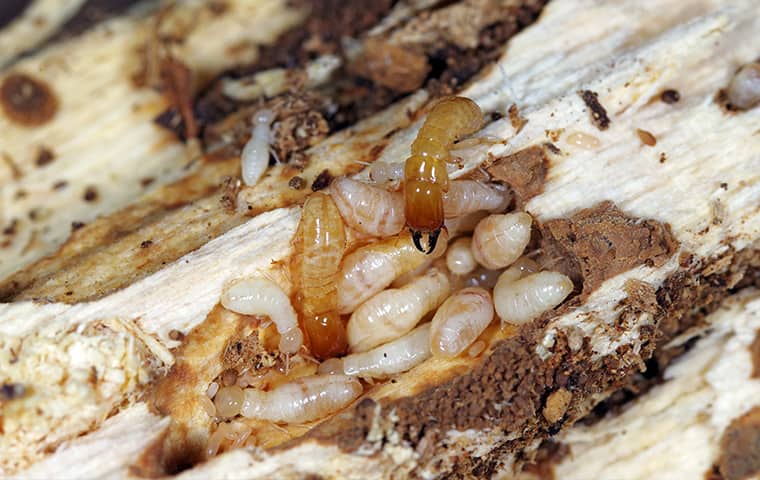Unfortunately, spotting the signs of termites can be difficult, as termites can live on your property for years without making their presence known.
Luckily, this guide will help you manage termites in Maryland and across the country and determine the best ways to get rid of termites and prevent them from coming back.
Termites in Maryland
Termites are social insects that live together in large colonies and feed on items made of cellulose.
When living and feeding outside, termites play an important environmental role, helping to eliminate decaying matter.
However, when these pests go inside, they are quite destructive, as they feed on structural wood found in homes and other buildings.
The most common species found living in Baltimore is the Eastern subterranean termite. These termites are known for the distinctive mud tubes they use to borough into houses. They also tend to dwell under the soil of your house.

Types of Termites
Members of termite colonies are divided into different groups or castes: workers, soldiers, and reproductives (kings and queens).
Worker termites
Worker termites comprise most of a colony’s members, gathering food for the entire colony. Workers have soft, creamy-white bodies and are blind and wingless.
Soldier termites
Soldier termites have the responsibility of guarding their termite colony from danger. They are larger than workers and have elongated, yellow heads, short legs, and large, powerful jaws. They typically only comprise around 2-5% of the termite population.
King & Queen termites
The reproductive members of a colony are its largest members, are dark brown to black in color, and are winged. They swarm from a mature termite colony in order to mate and create new nesting sites.
What Are Swarmers
Swarmers are winged termites that flock to new areas to establish new colonies. While swarmers are not dangerous to your home, they are typically signs of an impending termite infestation and should be dealt with immediately.
Are Termites Dangerous?
However, termites are considered to be dangerous pests because they cause significant structural damage to homes by tunneling through and feeding on wood found inside them.
One difficult aspect of dealing with termites is that they can often be active for years without being spotted. Termites can enter homes and feed on the interior while leaving the home’s exterior intact.
Otherwise, termites do not bite people, aren’t known to transmit any diseases, and seldom even come into contact with people.
Why Do I Have a Termite Problem?
Eastern subterranean termites live and feed in the soil. However, they may enter your home if it provides a good source of food and water.
Some of the most common reasons termites end up on your property in the first place include:
- There are fallen trees, stumps, old roots, and branches surrounding the property.
- Your property has damp soil in wooded, shaded areas.
- Soil on your property comes into contact with door frames, wooden play structures, deck posts, wood shingles, and porch steps or supports.
- There are cracks and crevices in your home’s foundation.
Therefore, a major part of prevention will be keeping your yard tidy to keep termites out of your house.
How to Find Termites In Your House? Common Signs
Termites are very difficult to detect if you don’t know the signs to look for.
Some of the most common signs of a termite infestation include:
- Mud Tubes: These are thin pencil-sized tubes that run up from the foundation of your home to any cracks or open window sills where termites can enter.
- Frass: This is the leftover cellulose material that termites discard while eating through your wood. Look for frass around framing members of the house and near windowsills or lying directly on the floor.
- Discarded Wings: When swarmers set up a new colony in your house, they will leave behind discarded wings on window sills and entry points.
- Damaged or Buckling Wood: While damaged wood can be mistaken for many things, it can also be a clear sign of a termite infestation. You may even see tiny pin-sized holes where termites enter.
- Cracked or Bubbling Paint: Termites can directly damage painted wood surfaces, causing the paint to crack. Investigate further to determine if this results from moisture, foundation, or termite damage.
How to Get Rid of Termites
Unfortunately, there are not a lot of DIY solutions for termites that are totally effective at getting rid of colonies. While you can experiment with different insecticides, you risk further damage to your house if you’re unsuccessful.
To eliminate wood-eating termites from your home or property and prevent a re-infestation, you’ll need to partner with a knowledgeable professional. At Pest Czar, our local and experienced professionals provide the modern techniques and technology needed to find and eliminate termites living in your home, outbuildings, or on your property.
Termite Prevention Tips
Preventing problems with termites can be tricky. But, as we previously mentioned, you can do many things to prevent termites by sealing your house and cleaning up your yard.
Some expert recommended tips include:
- Put into place a professional termite control program.
- Remove fallen trees, tree stumps, and other piles of organic debris from your property.
- Place weather stripping around windows and doors to prevent water from seeping into your home.
- Maintain your home’s gutters to properly irrigate soil and prevent foundation damage where termites can enter.
- Repair leaky pipes, faucets, or fixtures located inside and outside your home.
- Remove water-damaged wood from your home.
- Limit soil-to-wood contact near or in your home.
- Use dehumidifiers to reduce moisture levels in your home.
- Leave a stone barrier between any soil or mulch and your home’s foundation.
How Often Should You Get a Termite Inspection?
You may think that conducting a yearly termite inspection may be too much money. However, the costs of an unmitigated termite infestation inside your home can be astronomically more expensive.
Due to the stealthy and destructive nature of termites, we recommend homeowners conduct a termite inspection at least annually, if not seasonally. This ensures that there are no active termite colonies or infestations of any kind in your home.
Pest Czar’s Czar Guard Plus provides active protection against termites and 40 other different species of pests using the patented Sentricon® System with Always Active™ defense. Contact us today to inquire about termite prevention and removal services, and speak to a representative to get your free quote!
Helpful Articles
How to Kill Termites Before They Destroy Your Property
The Homeowners Guide to Getting Rid of Subterranean Termites
Are Termites In Baltimore Harmful To Humans?
Why Sentricon® Is The Ultimate Termite Defense For Residents
Get Started Today with a Free Quote
Complete the form below to schedule your no obligation inspection.
- Zero-Contact Service
- Same-Day Inspection/Service
- Real-Time Notifications

Customer Reviews
“Joe is knowledgeable and professional. Thanks for the great service!”
Adam | Reisterstown, MD | Read Reviews


